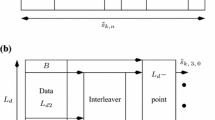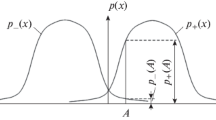Abstract
In this paper, we consider possible solutions for noncoherent decoding of concatenated codes with spectrally efficient modulations. Two main classes of schemes are considered. A first class is obtained by concatenating parallel coding schemes with differential encoding. A second class considers serially concatenated coding structures and possible schemes derived from turbo trellis coded modulation (t-tcm), which do not employ differential encoding. In the first case, at the receiver side we consider separate detection and decoding, while in the second case we consider joint detection and decoding. The major problem connected with such an iterative decoding procedure is that taking into account an augmented channel memory leads to an intolerable trellis size, and hence to an impractical decoding complexity. Reduced-complexity techniques suited to iterative decoding become fundamental, and we consider a recently proposed state-reduction technique. This way, the performance of a coherent receiver is approached, by keeping the number of receiver states fixed.
Résumé
Dans cet article on étudie les solutions envisageables pour le décodage non-cohérent des codes concaténés associés à des modulations à forte efficacité spectrale. Deux principaux types de schéma sont considérés. Le premier type est obtenu par concaténation d’un turbocode parallèle avec un codeur différentiel. Le second type utilise des concaténations en série associées à un des schéma dérivé de turbo modulations codées en treillis (ttcm) sans utiliser de codeur differéntiel. Dans le premier cas, du côté réception, on considère séparement la détection et le décodage, tandis que dans le second cas, on les considère conjointement. Le principal problème d’un procédé itératif de décodage est que prendre en compte une mémoire du canal supplémentaire conduit à une taille de treillis prohibitive, et done à une complexité de décodage trop importante. Appliquer des techniques de réduction de complexité au décodage itératif devient indispensable et on a considéré une méthode récemment proposée de réduction des états. De cette façon, en gardant un nombre d’états du récepteur fixe, les performances d’un récepteur cohérent sont approchées.
Similar content being viewed by others
References
Berrou (C), Glavieux (A.), “Near optimum error correcting coding and decoding: turbo-codes,”ieee Trans. Commun., vol. 44, pp. 1261–1271, October 1996.
Benedetto (S.), Divsalar (D.), Montorsi (G.), Pollara (R), “Serial concatenation of interleaved codes: performance analysis, design, and iterative decoding,”ieee Trans. Inform. Theory, vol. 44, pp. 909–926, May 1998.
Ungerboeck (G.), “Channel coding with multilevel phase signaling,”ieee Trans. Inform. Theory, vol. IT-25, pp. 55–67, January 1982.
Le Goff (S.), Glavieux (A.), Berrou (C), “Turbo codes and high spectral efficiency modulation,” inProc. ieee Intern. Conf. Commun, (ICC ‘94), New Orleans, LA, U.S.A., May 1994, pp. 645–649.
Wahlen (B.E.), Mai (C.Y.), “Turbo coding applied to pragmatic trellis-coded modulation,”ieee Commun, Letters, vol. 4, n° 2, pp. 65–67, February 2000.
Roberston (P.), Worz (T), “A novel bandwidth efficient coding scheme employing turbo codes,”ieee J. on Sel. Areas in Comm., vol. 16, pp. 206–218, February 1998.
Benedetto (S.), Divsalar (D.), Montorsi (G.), Pollara (F), “Parallel concatenated trellis coded modulation,” inieee Proc. Intern. Conf. Commun. (ICC ’96), June 1996, pp. 974–978.
Minowa (T), Ogiwara (H.), “Application of soft-in soft-out Viterbi algorithm to turbo trellis-coded modulation,”ieice Trans. Fundam. of Elect., Commun. and Comp. Sciences, vol. E81-A, n° 10, pp. 2047–2054, October 1998.
Benedetto (S.), Montorsi (G.), “Versatile bandwidth-efficient parallel and serial turbo trellis-coded modulation,” inProc. Intern. Symp, on Turbo Codes & Relat. Topics (istc’00), Brest, France, September 2000, pp. 201–208.
Colavolpe (G.), Ferrari (G.), Raheli (R.), “Noncoherent iterative (turbo) decoding,”ieee Trans, Commun, vol. 48, n° 9, pp. 1488–1498, September 2000.
Colavolpe (G.), Raheli (R.), “The capacity of the noncoherent channel,” European Transactions on Telecommunications, vol. 12, n°4, July-August, 2001.
Deng (R.G.), Costello (D.J.), Jr., “High rate concatenated coding systems using bandwidth efficient trellis inner codes,”ieee Trans. Commun., vol. 37, n° 5, pp. 420–427, May 1989.
Colavolpe (G.), Ferrari (G.), Raheli (R.), “Reduced-state BCJR-type algorithms,”ieee J. Sel. Areas Comm., vol. 19, n°5, pp. 849–859, May 2001.
Biglieri (E.), Divsalar (D.), McLane (P.J.), Simon (M.K.), “Introduction to trellis-coded modulation with applications,” Macmillan Publishing Company, 1991.
Colavolpe (G.), Raheli (R.), “Noncoherent sequence detection,”IEEE Trans, Commun., vol. 47, n° 9, pp. 1376–1385, September 1999.
Fragouli (C), R. D. Wesel (R.D.), “Symbol interleaved parallel concatenated trellis coded modulation”, inProc. IEEE Intern, Conf, Commun,-Comm. Theory Min-Conf, (ICC-CTMC ‘99), Vancouver, Canada, June 1999, pp. 42–46.
M. V. Eyuboglu (M.V.), Qureshi (S.U.H.), “Reduced-state sequence estimation with set partitioning and decision feedback,”IEEE Trans, Commun., vol. 36, pp. 13–20, January 1988.
Duel-Hallen (A.), Heegard (C), “Delayed decision-feedback sequence estimation,”ieee Trans, Commun., vol. 37, pp. 428–436, May 1989.
Chevillat (PR.), Eleftheriou (E.), “Decoding of trellis-encoded signals in the presence of intersymbol interference and noise,”IEEE Trans, Commun., vol. 37, pp. 669–676, July 1989.
Raphaeli (D.), “Noncoherent coded modulation,”ieee Trans, Commun., vol. 44, n° 2, pp. 172–183, February 1996.
Benedetto (S.), Divsalar (D.), Montorsi (G.), Pollara (E), “A soft-input soft-output app module for iterative decoding of concatenated codes,”IEEE Communications Letters, vol. 1, pp. 22–24, January 1997.
Wei (L.-R), “Rotationally invariant convolutional channel coding with expanded signal space-Part 1; 180°”,IEEE J. on Sel. Areas in Comm., vol.2, n° 5, pp. 659–671, September 1984.
Wei (L.-E), “Rotationally invariant convolutional channel coding with expanded signal space-Part II: nonlinear codes”,ieee J. on Sel. Areas in Comm., vol. 2, n° 5, pp. 672–686, Sept. 1984.
Pietrobon (S.S.), Ungerboeck (G.), Perez (L.C.), Costello (D.J.), Jr., “Rotationally invariant nonlinear trellis codes for two-dimensional modulation,”ieee Trans. Inform. Theory, vol. 40, pp. 1773–1791, November 1994.
Liu (W.), Wilson (S.G.), “Rotationally-invariant concatenated (turbo) tcm codes,”Conference Record of Thirty-Third Asilomar Conference on Signals, Systems and Computers, Monterey, California, October 1999, pp. 32–36.
Robertson (P.), Villerbrun (E.), P. Hoeher (P.). “Optimal and sub-optimal maximum a posteriori algorithms suitable for turbo decoding,”Europ. Trans. on Telecommun., (ETT), vol. 8, n° 2, pp. 119–125, March-April 1997.
Colavolpe (G.), Ferrari (G.), Raheli (R.), “Extrinsic information in turbo decoding: a unified view”, to be published inieee trans. Commun., 2001. Also inProc. IEEE Global Telecom. Conf. (GLOBECOM ‘99), Rio de Janeiro, Brazil, December 1999, pp. 505–509.
Proakis (J.G.), “Digital communications”,McGraw-Hill International Editions, 1995.
Author information
Authors and Affiliations
Rights and permissions
About this article
Cite this article
Ferrari, G., Colavolpe, G. & Raheli, R. Noncoherent iterative decoding of spectrally efficient coded modulations. Ann. Télécommun. 56, 409–421 (2001). https://doi.org/10.1007/BF02995452
Received:
Accepted:
Issue Date:
DOI: https://doi.org/10.1007/BF02995452




